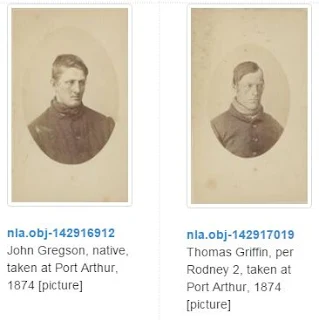
Provenance
The National Library of Australia's collection of police mugshots - originals of which were taken at the Hobart Gaol, Campbell St. Hobart and at the Mayor's Court, Municipal Police Office, Hobart Town Hall, by government contractor Thomas J. Nevin from 1872-1886 - was acquired by the NLA from two main sources: twelve (12) "archival estrays" formerly the property of the Tasmanian government, were donated by historian Dr Niel Gunson in 1964; and copies of the seventy (70) cdv's exhibited at the QVMAG in 1977 as the work of T. J. Nevin were presented to the NLA by the exhbition's curator John McPhee in 1984, housed in an album from the John Watt Beattie collection. It was during the 1980s that the QVMAG's collection of Tasmanian "convict" photographs was dismantled, and distributed piecemeal to various public institutions, including the Tasmanian Museum and Art Gallery (57) and the Port Arthur Historic site.
Full records with T. J. Nevin's attribution as the professional photographer commissioned to photograph Tasmanian prisoners on incarceration and discharge are held at the NLA, in Sprod Papers NLA MS 2320. The National Library of Australia has recently updated its digital software, yet the versos of these photographs, which can provide researchers with valuable information. have not been digitised. The NLA believes that the absence of a photographer's studio stamp on the versos - of police mugshots no less - is reason enough to engage in puerile political games of re-attribution, despite expert curatorial validation, and Nevin's government contract stamp on several of these mugshots held in other national collections. The versos of the majority of these photographs were incorrectly transcribed ca. 1890s-1900s with the wording "Taken at Port Arthur 1874" to promote penal heritage tourism to Tasmania when they were sent as exhibits to the Royal Hotel, Sydney, in conjunction with an exhibition of convictaria on the fake transport ship, the Success, which toured Hobart, Brisbane, Melbourne and Adelaide before returning to Sydney. The majority of the 85 mugshots in the NLA collection consists of copies either duplicated from the originals - or missing from - the collections held at the Tasmanian Museum and Art Gallery, Hobart and the Queen Victoria Museum and Art Gallery, Launceston.

Webshot 2007: Photographer Nevin, Thomas J.
NLA Pictorial list of Convict portraits, Port Arthur 1874

















Offline and in situ
Offline and viewed in situ at the National Library of Australia in the plastic folder sleeves and pockets (see examples below) in which they are housed, these very old 1870s and 1880s photographs of Tasmanian prisoners lose a good deal of their visual appeal which they otherwise seem to project when enlarged and digitised for online viewing. The staff at the National Library of Australia readily protest that these photographs are prized as unique artefacts when confronted with criticism about the way they are treating their collection. Yet the plastic pockets - which are not the celluloid pockets used for other photographs in their collections - are contributing to the decay of these photographs and is clear evidence that the NLA staff prefer to dissemble, at times even respond with aggression when called out.
Likewise, the manner in which the NLA staff since 2007 have compromised government contractor Thomas J. Nevin's historically correct attribution as the commercial photographer of these mugshots with baseless tourist propaganda from Port Arthur employees playing the events-of-1996 sympathy card, is inflicting damage of another kind to the nation's cultural memory which these photographs inform. They should at the very least receive mature and professional treatment, but Australia's cultural heritage, it seems in this instance, is not necessarily immune from abuse by the very public institution entrusted to preserve it.
Example folder 1: rectos (below)

Example folder 1: versos (below)

Example folder 2: rectos (below)

Example folder 2: versos (below)

Example folder 3: rectos (below)

Example folder 3: versos (below)

Tasmanian prisoner mugshots - or "Port Arthur convicts 1874"
Taken at the NLA January 2015
Photos copyright © KLW NFC Imprint 2015

State Library of NSW
[`Success' fake convict ship at Circular Quay, Sydney]
Call Number SPF / 763
Digital Order No. a089763
Fake and Fortune
The inscription - "Taken at Port Arthur, 1874" - on the verso of more than 300 extant cartes-de-visite copies of the original captures on glass by T. J. Nevin in the one sitting with the prisoner in the 1870s, together with the convict's name and ship on which he was transported - was mere touristic spin to tempt the intercolonial tourist to visit the ruins of Port Arthur, and to buy a cdv as a souvenir, perhaps a cdv of their criminal forebears. It was added to the versos by John Watt Beattie and his assistant at his highly profitable "Port Arthur Museum" in Hobart, and dates from the 1890s-1920s. His reproductions and montages of these 1870s mugshots of Tasmanian prisoners - touted as "Port Arthur convicts"- were displayed on the fake convict ship, the Success, during visits to Hobart, Brisbane, Adelaide, and Sydney. The "belief" published by Chris Long in 1995 (Directory of Tasmanian Photographers 1840-1940, TMAG) that A. H. Boyd, as Commandant at Port Arthur until December 1873, was the photographer of these Tasmanian prisoners is a deliberate falsification of the facts, a doubling down of misinformation and disinformation in the name of dark tourism. A. H. Boyd was not a photographer by any definition of the term and played no part in their production and supply by government contractor T. J. Nevin at the Hobart Gaol, Campbell St. Hobart in the years 1872 to 1886.
Search this site for detailed police records for each prisoner's mugshot.
RELATED POSTS main weblog
- Rogues Gallery: Tasmanian Museum and Art Gallery Collection
- Thomas Nevin's glass plates of prisoners 1870s
- Nevin's convict portraits at the National Library of Australia
- Julia Clark: A Question of Stupidity and the NLA
- Improprieties: A.H. Boyd and the parasitic attribution
- The Queen Victoria Museum & Art Gallery Convicts 1977

